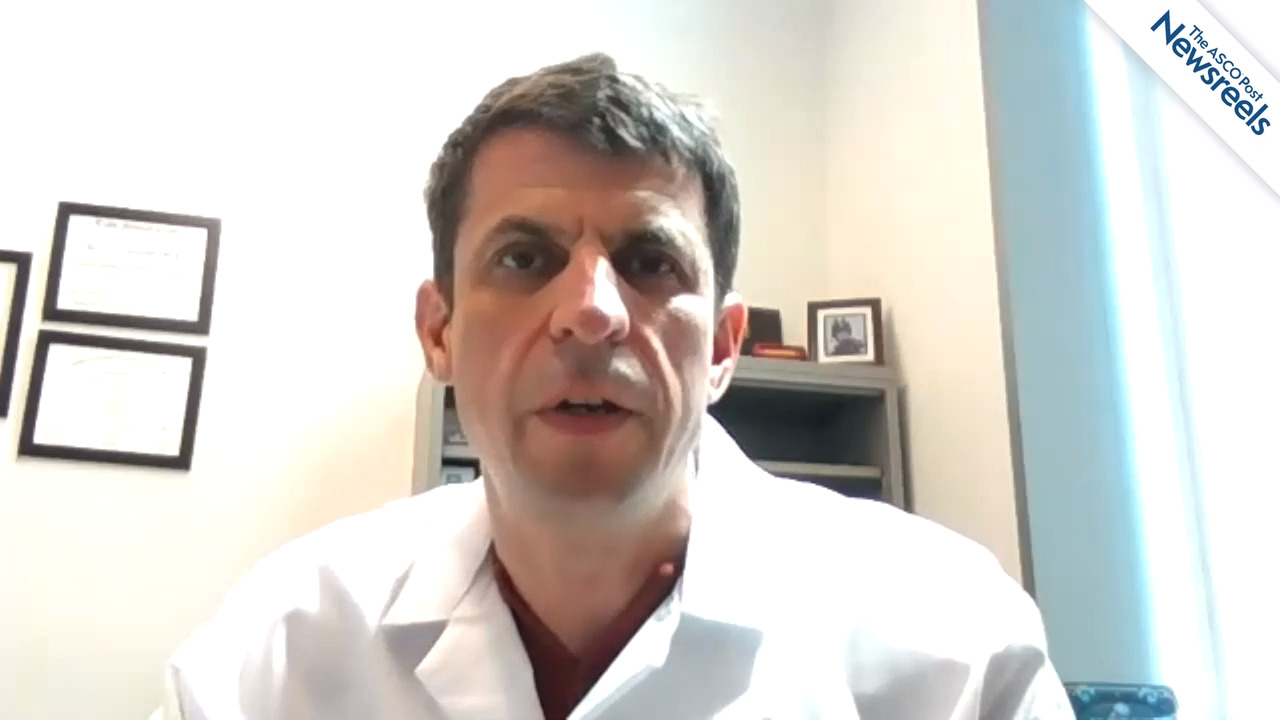Study Reveals Gaps in Code Status Discussions Among Patients With High-Risk AML
Oncologists and health-care professionals who treat patients with high-risk acute myeloid leukemia (AML) are missing important opportunities to have end-of-life discussions at earlier stages in the disease course, when patients are best able to discuss their options and preferences. These findings...
Ivosidenib/Azacitidine vs Azacitidine Alone in Patients With Newly Diagnosed IDH1-Mutated AML
In the phase III AGILE trial, the combination of ivosidenib and azacitidine was found to be superior in treating newly diagnosed patients with IDH1-mutated acute myeloid leukemia (AML) compared to azacitidine alone in terms of event-free survival, the study’s primary endpoint. The combination also...
Antibody Response to Second Dose of mRNA COVID-19 Vaccine in Patients With AML and MDS
In one of the largest studies to date of the antibody response to vaccination against COVID-19 in people who had been treated for acute myeloid leukemia (AML) and myelodysplastic syndrome (MDS), patients responded well to two doses of the Moderna mRNA vaccine and saw a pronounced increase in levels ...
Paolo Ghia, MD, PhD, on CLL: New Data on Treatment With Ibrutinib Plus Venetoclax
Paolo Ghia, MD, PhD, of the Università Vita-Salute San Raffaele and IRCCS Ospedale San Raffaele, discusses disease-free survival results from the measurable residual disease cohort of the phase II CAPTIVATE trial. This multicenter trial focuses on first-line ibrutinib plus venetoclax in patients with chronic lymphocytic leukemia (Abstract 68).
Study Reveals Underrepresentation of AYA Hispanic Patients in a Large ALL Clinical Trial
A study of U.S. adolescent and young adult patients with acute lymphoblastic leukemia (ALL) found that Hispanic patients were significantly underrepresented in a large clinical trial compared with the general patient population. The study, presented by Muffly et al at the 2021 American Society of...
Outcomes Among Pediatric and Young Adult Patients With ALL Differ By Race, Ethnicity, and Socioeconomic Status
A study of nearly 25,000 patients with acute lymphoblastic leukemia (ALL) aged up to 30 years old revealed significant gaps in survival rates between White, Hispanic, and Black patients, as well as worse outcomes among those of lower socioeconomic status. Biologic or genetic factors accounted for...
Brexucabtagene Autoleucel for Relapsed or Refractory B-Cell Precursor ALL
On October 1, 2021, the CD19-directed chimeric antigen receptor (CAR) T-cell therapy brexucabtagene autoleucel was approved for adults with relapsed or refractory B-cell precursor acute lymphoblastic leukemia (ALL).1 The product is available only through a restricted program under a Risk Evaluation ...
Asciminib for Philadelphia Chromosome–Positive Chronic Myeloid Leukemia
On October 29, 2021, the oral kinase inhibitor asciminib was granted accelerated approval for adults with Philadelphia chromosome–positive chronic myeloid leukemia (CML) in chronic phase previously treated with at least two tyrosine kinase inhibitors and regular approval for adults with...
Next-Generation Sequencing of Bone Marrow DNA to Predict Relapse Following CAR T-Cell Therapy in Patients With ALL
Next-generation sequencing of bone marrow samples from pediatric and young adult patients with acute lymphoblastic leukemia (ALL) treated with tisagenlecleucel was more accurate in predicting relapse than flow cytometry and monitoring of B-cell aplasia, according to the results from a study by...
FDA Approves Rituximab Plus Chemotherapy for Several Pediatric Hematologic Malignancies
On December 2, the U.S. Food and Drug Administration (FDA) approved rituximab (Rituxan) in combination with chemotherapy for pediatric patients (≥ 6 months to < 18 years old) with previously untreated, advanced-stage, CD20-positive diffuse large B-cell lymphoma (DLBCL), Burkitt lymphoma,...
COG AAML1331 Trial: Arsenic Trioxide and All-Trans Retinoic Acid in Pediatric Patients With APL
As reported in JAMA Oncology by Kutny et al, the Children’s Oncology Group (COG) AAML1331 trial has shown that treatment with arsenic trioxide and all-trans retinoic acid (ATRA) with no maintenance therapy produced high event-free and overall survival rates in pediatric patients with acute...
Impact of Prior Blinatumomab Exposure on CD19-Targeted CAR T-Cell Therapy Outcomes in Pediatric Patients With B-Cell ALL
In a study reported in the Journal of Clinical Oncology, Myers et al found that lack of response to prior blinatumomab treatment was associated with poorer outcomes with CD19-targeted chimeric antigen receptor (CAR) T-cell therapy (CD19-CAR) in children and young adults with relapsed or refractory...
Novel Therapies Under Study in Acute Myeloid Leukemia
Newly identified genetic abnormalities in acute myeloid leukemia (AML), as well as therapies that can target some of those abnormalities, are now available as the landscape for treatment continues to evolve. During the 2021 National Comprehensive Cancer Network (NCCN) Annual Congress: Hematologic...
Novel Therapies Under Study in Acute Myeloid Leukemia
Newly identified genetic abnormalities in AML have led to novel therapies that can target some of them, as the landscape for treatment continues to evolve. During the 2021 National Comprehensive Cancer Network (NCCN) Annual Congress: Hematologic Malignancies, Alice S. Mims MD, presented updates in...
Study Examines Availability of All-Trans Retinoic Acid in U.S. Hospitals
New research published by Geer et al in JNCCN—Journal of the National Comprehensive Cancer Network has found that fewer than one-third of hospitals in the United States had immediate availability of all-trans retinoic acid (ATRA), a crucial blood cancer medication. ATRA is initiated early in the...
Novel Drug Combination May Help Children With Acute Promyelocytic Leukemia Avoid Conventional Chemotherapy
A clinical trial recently published by Kutny et al in JAMA Oncology found that the combination of all-trans retinoic acid and arsenic trioxide was highly effective in children with standard- and high-risk acute promyelocytic leukemia (APL). Nearly all patients in the trial survived for 2 years...
Measurable Residual Disease Dynamics and Extended Follow-up in CLL14 Trial of Venetoclax/Obinutuzumab in Previously Untreated Chronic Lymphocytic Leukemia
In an analysis of the pivotal CLL14 trial reported in the Journal of Clinical Oncology, Al-Sawaf et al found that venetoclax plus obinutuzumab was associated with higher rates of undetectable measurable residual disease (MRD) and prolonged MRD doubling time vs chlorambucil plus obinutuzumab at 3...
Jennifer A. Woyach, MD, on CLL/SLL: Using Minimal Residual Disease Assessment in Clinical Practice
Jennifer A. Woyach, MD, of The Ohio State University Comprehensive Cancer Center, talks about whether modifications of treatment based on minimal residual disease is beneficial to patients with chronic lymphocytic leukemia and small lymphocytic lymphoma.
Alice S. Mims, MD, on AML: Updates on Managing Newly Diagnosed Disease
Alice S. Mims, MD, of The Ohio State University Comprehensive Cancer Center, discusses the many positive changes over the past 5 years in treating patients with newly diagnosed acute myeloid leukemia in the upfront setting. She also details future directions, including further combining therapies with targeted agents, the potential use of all-oral regimens, and using measurable residual disease as a possible endpoint in treatment responses.
Study Finds Type I Interferon May Enhance the Antileukemia Effect of Allogeneic Transplantation
In a study published by Magenau et al in the journal Blood Advances, researchers found that patients with high-risk acute myeloid leukemia (AML) who received a form of type I interferon after allogeneic hematopoietic stem cell transplant experienced reduced rates of disease relapse. Additionally,...
FDA Approves Asciminib for Philadelphia Chromosome–Positive CML
On October 29, the U.S. Food and Drug Administration (FDA) granted accelerated approval to the kinase inhibitor asciminib (Scemblix) for patients with Philadelphia chromosome–positive chronic myeloid leukemia (Ph+ CML) in chronic phase who have been previously treated with two or more tyrosine...
Addition of Enasidenib to Azacitidine in Newly Diagnosed IDH2-Mutant Acute Myeloid Leukemia
As reported in The Lancet Oncology by Courtney D. DiNardo, MD, and colleagues, an interim analysis of the phase II portion of a phase Ib/II trial (AG221-AML-005) showed that the addition of the oral mutant IDH2 protein inhibitor enasidenib to azacitidine significantly improved overall response rate ...
Noninferior Progression-Free Survival and Reduced Cardiovascular Toxicity With Acalabrutinib vs Ibrutinib in Previously Treated CLL
As reported in the Journal of Clinical Oncology by John C. Byrd, MD, of The Ohio State University Comprehensive Cancer Center, and colleagues, the phase III ELEVATE-RR trial has shown noninferior progression-free survival with the more-selective Bruton’s tyrosine kinase (BTK) inhibitor...
BTK Inhibition in CLL: An Embarrassment of Riches
Chronic lymphocytic leukemia (CLL) is a B-cell lymphoproliferative disorder defined by a specific phenotype and the presence of more than 5,000 clonal B cells in the peripheral blood.1 In the absence of this number of circulating cells, its soft-tissue/bone-marrow counterpart is semantically...
Ibrutinib vs Placebo Following Achievement of Undetectable MRD With First-Line Ibrutinib/Venetoclax in CLL
As reported in the Journal of Clinical Oncology by William G. Wierda, MD, PhD, and colleagues, findings in the measurable residual disease (MRD) cohort of the phase II CAPTIVATE study indicated a high disease-free survival rate with placebo and no significant benefit of continued ibrutinib in...
A Look at Tomorrow’s CAR T-Cell Therapy Today
Some of the most impressive data on chimeric antigen receptor (CAR) T-cell therapy have come from studies conducted in China. Attendees at the 2021 Pan Pacific Lymphoma Conference heard from one of the leading Chinese investigators, Peihua (Peggy) Lu, MD, of Lu Daopei Hospital, who described the...
FDA Approves Brexucabtagene Autoleucel for Relapsed or Refractory B-Cell Precursor ALL
On October 1, the U.S. Food and Drug Administration (FDA) approved brexucabtagene autoleucel (Tecartus), a CD19-directed chimeric antigen receptor (CAR) T-cell therapy, for adult patients with relapsed or refractory B-cell precursor acute lymphoblastic leukemia (ALL). ZUMA-3 Efficacy was evaluated ...
Luis E. Aguirre, MD, on Chronic Myelomonocytic Leukemia: Keys to Assessment and Treatment
Luis E. Aguirre, MD, of the H. Lee Moffitt Cancer Center and Research Institute, discusses the subset of patients with chronic myelomonocytic leukemia who have a more indolent disease course. Features at diagnosis may include higher hemoglobin and platelet counts or JAK2, SF3B1, and IDH2 mutations; features associated with earlier initiation of treatment may include an elevated white blood cell count or a higher number of marrow blasts. Identifying the changes that occur between diagnosis and treatment are among future research goals (Abstract MDS-229).
Study Finds Genetic Predisposition to Higher Lymphocyte Production May Lead to Higher ALL Risk
Research published by Kachuri et al in the American Journal of Human Genetics reveals that children born with a genetic predisposition to produce more lymphocytes—particularly in relation to other types of white blood cells—may be at a higher risk of developing acute lymphoblastic leukemia (ALL)....
First-Line Acalabrutinib, Venetoclax, and Obinutuzumab for Chronic Lymphocytic Leukemia
In a phase II study reported in The Lancet Oncology, Matthew S. Davids, MD, and colleagues found that first-line triple combination therapy with acalabrutinib, venetoclax, and obinutuzumab produced measurable residual disease (MRD)-negative complete remission in a substantial proportion of patients ...
Fixed-Dose, First-Line Ibrutinib/Venetoclax Combination Achieves Durable Remissions in CLL
The combination of fixed-duration, first-line treatment with ibrutinib plus venetoclax achieved complete responses in more than half of patients with chronic lymphocytic leukemia (CLL)/small lymphocytic leukemia (SLL), based on the primary analysis of the fixed-dose cohort of the phase II CAPTIVATE ...
ELEVATE-RR Trial: Acalabrutinib as Effective as Ibrutinib, With Fewer Cardiac Effects, in Resistant CLL
Acalabrutinib was equally efficacious with less toxicity when compared directly with ibrutinib in patients with previously treated relapsed or refractory chronic lymphocytic leukemia (CLL), according to the results of an open-label, randomized, noninferiority phase III trial presented at the 2021...
Curtis Lachowiez, MD, on AML: Venetoclax Combined With FLAG-IDA
Curtis Lachowiez, MD, of The University of Texas MD Anderson Cancer Center, discusses data that show combining venetoclax with FLAG-IDA chemotherapy to treat patients with newly diagnosed acute myeloid leukemia led to minimal residual disease negativity in more than 90% of those achieving a composite complete response (Abstract AML-024).
AUTO1: CAR T-Cell Product for Adult Patients With Relapsed or Refractory B-Cell ALL
In a phase I trial (ALLCAR19) reported in the Journal of Clinical Oncology, Roddie et al found that the fast off-rate autologous CD19 chimeric antigen receptor (CAR) T-cell therapy CAT19-41BB-Z—also known as AUTO1—was well tolerated and produced high remission rates in adults with relapsed or...
ELEVATE-RR Trial: Acalabrutinib as Effective as Ibrutinib, With Fewer Cardiac Effects, in Resistant CLL
Acalabrutinib was equally efficacious with less toxicity when compared directly with ibrutinib in patients with previously treated relapsed or refractory chronic lymphocytic leukemia (CLL), according to the results of an open-label, randomized, noninferiority phase III trial presented at the 2021...
Ibrutinib and Cardiovascular Risk in Patients With Chronic Lymphocytic Leukemia
In a Canadian population-based cohort study reported in the Journal of Clinical Oncology, Abdel-Qadir et al found that ibrutinib treatment for chronic lymphocytic leukemia (CLL) is associated with increased risks of atrial fibrillation, bleeding, and heart failure, but not ischemic stroke or acute...
Study Suggests Demographic Enrollment Reporting Requirements for Acute Leukemia Clinical Trials Are Lacking
Requirements instituted to address racial and ethnic disparities in clinical trial enrollment did not lead to increased inclusion of Black and Hispanic participants in clinical acute leukemia research, according to a new study published by Andrew Hantel, MD, and colleagues in the journal Blood...
Effect of Concurrent Focal 22q11.22 Deletions and IKZF1 Alterations on Outcomes in Pediatric Patients With B-Cell ALL
In a study reported in JAMA Oncology, Mangum et al found that focal deletions in chromosome 22q11.22 were associated with poor outcomes in pediatric patients with B-cell acute lymphoblastic leukemia (ALL) with IKZF1 alterations. As stated by the investigators, “Alterations in the IKZF1 gene drive...
Study Explores Relationship Between Anti-CD20 Therapy and Reduced Responses to mRNA COVID-19 Vaccines
Patients with lymphoma or other lymphoid cancers should continue to take steps to protect themselves from COVID-19 even if they have been vaccinated against the disease, a new study by Jennifer Crombie, MD, and colleagues published in Blood Advances suggests. The study found that patients who had...
Outcomes Notably Improving for Adult ALL
Outcomes in adults with acute lymphoblastic leukemia (ALL) are almost rivaling those in pediatric ALL, thanks to the benefits achieved by incorporating blinatumomab and inotuzumab into chemotherapy regimens. New ways of administering the chemotherapy component are also increasing tolerability and...
Study Identifies Possible New Genetic Biomarkers of Pediatric Leukemia
In a study published by Magnum et al in JAMA Oncology, researchers reported on how two separate DNA changes appear to predict aggressive childhood leukemias when they occur in combination. The team evaluated tumor characteristics of more than 1,300 pediatric patients with B-cell acute lymphoblastic ...
Donor-Derived CD7 CAR T Cells May Lead to Remissions in Patients With Relapsed or Refractory T-ALL
In a Chinese single-institution phase I study reported in the Journal of Clinical Oncology, Pan et al found that donor-derived CD7 chimeric antigen receptor (CAR) T-cell therapy produced a high complete remission rate in patients with relapsed or refractory T-cell acute lymphoblastic leukemia...
Experimental Small-Molecule Inhibitor May Improve Responses to Cellular Therapies in Advanced CLL
Too many “exhausted” T cells left in the wake of aggressive chemotherapy regimens for patients with advanced chronic lymphocytic leukemia (CLL) make it more challenging for chimeric antigen receptor (CAR) T-cell therapy to do its job. Now, a new study from researchers at the Perelman School of...
Alexey V. Danilov, MD, PhD, on Lymphoid Malignancies: Novel Agents Targeting BTK Inhibitor–Resistant Disease
Alexey V. Danilov, MD, PhD, of City of Hope, discusses the uses and side effects of cellular and immune therapies, including venetoclax and obinutuzumab, which may prove to be effective in treating highly resistant lymphoid malignancies such as chronic lymphocytic leukemia.
FDA Pipeline: Reviews for Agents in Lung Cancer, Thyroid Cancer, Kidney Cancer, and More
Recently, the U.S. Food and Drug Administration (FDA) accepted applications for agents aiming to treat non–small cell lung cancer (NSCLC), differentiated thyroid cancer, renal cell carcinoma (RCC), hypersensitive acute lymphoblastic leukemia (ALL), mucosal melanoma, and endometrial carcinoma....
Asparaginase Erwinia Chrysanthemi (Recombinant)-rywn for Acute Lymphoblastic Leukemia and Lymphoblastic Lymphoma
On June 30, 2021, asparaginase erwinia chrysanthemi (recombinant)-rywn was approved as a component of a multiagent chemotherapeutic regimen for treatment of acute lymphoblastic leukemia (ALL) and lymphoblastic lymphoma in adult and pediatric patients 1 month or older who have developed...
Expert Point of View: Jacqueline C. Barrientos, MD, MS
The ASCO Post invited Jacqueline C. Barrientos, MD, MS, Associate Professor of Medicine, CLL Research and Treatment Program, Zucker School of Medicine at Hofstra/Northwell, Lake Success, New York, to comment on the ALPINE findings presented at the European Hematology Association (EHA) Virtual...
Zanubrutinib Superior to Ibrutinib for CLL/SLL in Phase III ALPINE Trial
Zanubrutinib, a second-generation Bruton’s tyrosine kinase (BTK) inhibitor, significantly improved response rates and delayed disease progression as compared with the standard of care, ibrutinib, in patients with relapsed or refractory chronic lymphocytic leukemia or small lymphocytic lymphoma...
ELEVATE-RR Trial: Acalabrutinib vs Ibrutinib in Previously Treated Patients With CLL
As reported in the Journal of Clinical Oncology by John C. Byrd, MD, and colleagues, the phase III ELEVATE-RR trial has shown noninferior progression-free survival with the more selective Bruton’s tyrosine kinase (BTK) inhibitor acalabrutinib vs the less selective inhibitor ibrutinib in previously...
Expert Point of View: Guru Subramanian Guru Murthy
Invited discussant Guru Subramanian Guru Murthy, MD, MS, of the Medical College of Wisconsin, Milwaukee, commented on the study of aspacytarabine in the first-line therapy for patients with acute myeloid leukemia (AML) unfit for standard chemotherapy. “This study elegantly highlights there is still ...






